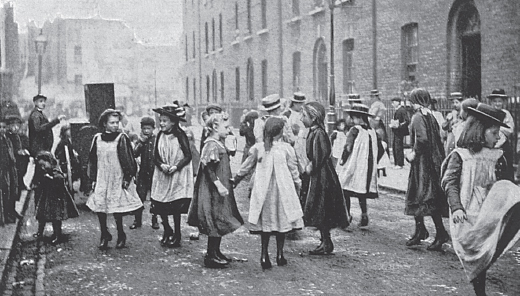
The London streets served as social venues for much of the population (circa 1900).
‘The law demands that we atone, when we take things we do not own, but leaves the lords and ladies fine, who take things that are yours and mine.’
– Verse from ‘The Goose and the Common’ protest rhyme, circa 1600s.
Life was a daily struggle for many Londoners at the start of the new century. Edwardian society was a knife-edge between the financially comfortable and the poor, barely softened by the middle class. Millions of servants in Britain supplied a seemingly endless source of labour to the upper classes. The wealthy and the middle class believed the lower classes to be unclean and untrustworthy – an opinion that stemmed not so much from reasoning as from upbringing.
Another prevalent assumption was the correlation between poverty and criminality. A colour-coded poverty map created by Charles Booth in 1898–992 identifies seven economic levels of London occupants ranging from ‘ Upper-middle and Upper classes. Wealthy.’ at the top, down to ‘Lowest class. Vicious, semi-criminal.’ at the bottom.
Viciousness apparently took effect one level below ‘ Very poor, casual. Chronic want.’ and two levels below ‘Poor. 18s. to 21s. a week for a moderate family.’ Booth delegated the remainder of London’s population to Mixed (some comfortable, others poor), Fairly comfortable (good ordinary earnings) or Middle class (well-to-do).
Booth’s maps helped spur widespread social and economic reform in London in the early twentieth century. Two other things are notable about his endeavour. First, he assigned ethics to only the poorest class of Londoners, labelling them vicious semi-criminals – he made no ethical judgements as he moved up the social scale. And second, he proved himself wrong.
Booth originally undertook his mapping to contradict a statement made by Henry Hyndman, leader of Britain’s first socialist party. Hyndman estimated that twenty-five per cent of the population of London was so poor as to be living below the level of basic subsistence. Booth felt that number was too high. The reality turned out to be much worse: by 1900, more than a third of London’s residents were desperately poor.
Booth would have had a difficult time slotting artists or models into one of his neat little categories. Creative communities tend to blur economic lines. You can see it in the maps: the pale rose and grey cross-hatchings of Mixed and Poor households in Soho edging north into Fairly Comfortable and Middle Class in Fitzrovia and east into Bloomsbury. Hidden in Booth’s coloured shapes were the artists and models that would put a face to cultural change in Britain and the writers that would give it a voice.
The artists, in particular, were a mixed group. They gravitated toward areas of London that offered the cost of living and creative energy they needed. John Singer Sargent had a fashionable house in Tite Street, Chelsea, with his studio conveniently next door. Sargent, London’s favourite society painter, lived quite well compared to most artists of the day. Tite Street itself was an intellectual nexus, home to numerous writers, artists and composers, including Oscar Wilde before Sargent, and Augustus John after him.
Most artists were not so lucky. A London machinist could count on seventy or eighty shillings a week in 1903, whereas an artist without family money would have to scrape by from sale to sale. It was hard to be creative if you were hungry all the time. And so, for sheer artistic density, the more affordable parts of Fitzrovia and Soho beckoned. The formerly elite Bloomsbury area was also a contender.
These were the streets that reverberated most strongly with ghosts restless for one final muse. It was easy to imagine the shade of John Constable walking from his studio at the back of no. 76 Charlotte Street to lean against the whitewashed bricks of the façade. By 1900 Constable was 63 years gone, his heart giving out in an upstairs bedroom.

The London streets served as social venues for much of the population (circa 1900).
By the early twentieth century, Constable’s ghost was more likely to appear to those who stayed too long at The Hundred Marks pub on the corner of Charlotte and Windmill Streets. No artist worth his salt would stroll by The Hundred Marks without popping in to see if a friend had sold a painting and was in the money. In that case it would be drinks all round, watched over by another ghost – the eponymous windmill of almost two centuries earlier.
This part of London was a fertile hunting ground for inspiration. If an instructor from the Slade or Saint Martin’s needed more models, it was a short walk to pavements teeming with potential amateur posers. For a young woman in need of income, that would be a start, and then she might find work in the studios if she proved punctual and uncomplaining.
It was fairly common for an artist to use several different models for an important picture, one for the figure, another for the hands, the facial expression, and so on – even the hair – to help ensure a happy client. In 1904, painter Frank Dicksee reportedly only employed models with copper-coloured hair. It was a case of art imitating life, as the craze for henna tint had hit London with full force.
Brunette, copper, or blonde, female models were often united by circumstance, spotted by chance, plucked from obscurity and anonymous. Few became true muses to the artists they served, but even the most novice posers occupy a unique place in history. They were a source of inspiration at a crucial time in British art, when four remarkable tides were rising in London: internationalism, modernism, feminism and war.